The hippopotamus and crocodile are two of Africa’s most dangerous animals. The two semiaquatic animals usually maintain a distance, so they’re rarely seen together. If we’re comparing a hippo vs crocodile, there are some similarities but quite a few differences to be aware of.
Adult hippos are much larger than crocodiles weighing up to 9,500 pounds compared to crocodiles, who average around 2,000 pounds. Crocodiles are more nimble in water and have a stronger bite force of 3,700 psi, while hippos, although more agile on land, only have a 1,800 psi bite force.
With different bite forces, weights, lengths, and more, there are a lot of essential features these two animals have developed for their survival in the animal kingdom.
Considering that, let’s examine the similarities and differences between the hippopotamus and the crocodile.
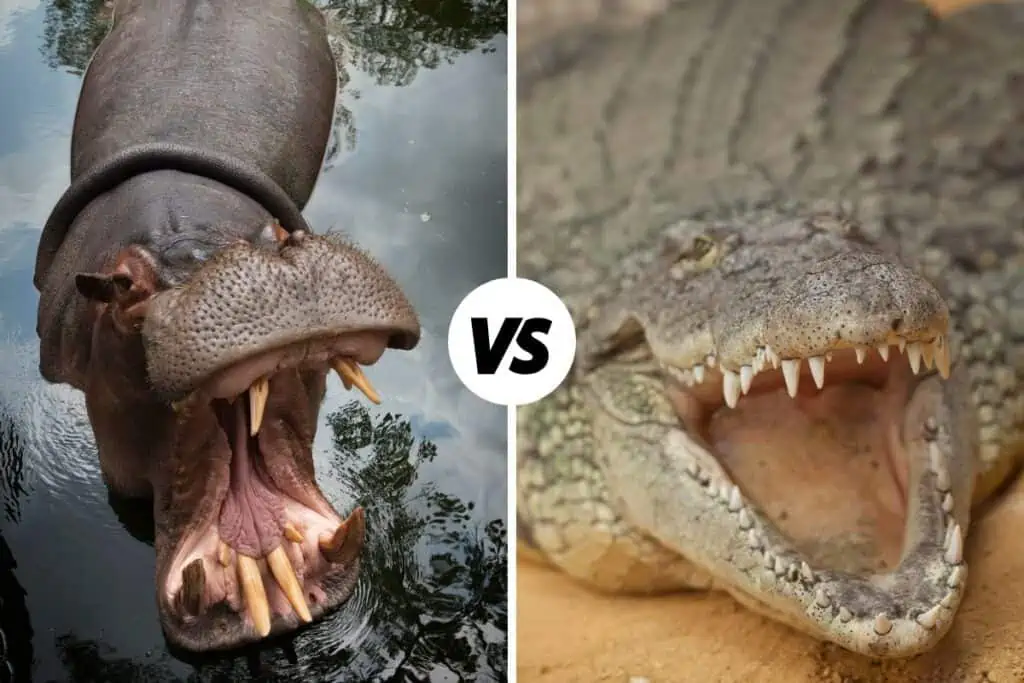
Crocodile vs Hippo Comparison
Some rivers are more dangerous than others, and the Nile crocodile is one of the most dangerous animals in Africa.
It is estimated that it carries out more attacks annually than all other crocodile species combined.
Contrary to crocodiles, hippos are Africa’s most dangerous and aggressive animals.
They frequently attack other animals who enter their territory and, unlike crocodiles, can and will capsize small boats.
But what makes hippos more dangerous compared to crocs? Let’s dive into some interesting facts about each of these animals.
8 Surprising Hippopotamus Facts
Large, heavy, and water-loving hippopotamuses are primarily herbivores native to Africa.
Although hippos and horses are not closely related, the word “hippopotamus” is derived from the Greek term meaning “water horse” or “river horse.”
According to the San Diego Zoo, pigs, whales, and dolphins are hippos’ closest living relatives.
Hippopotamuses come in two species: the common river hippo and the much smaller pygmy hippo.
However, despite their cute appearance, hippos are among the most aggressive and dangerous mammals.

With the common river hippo in mind, here are eight interesting facts:
- The hippopotamus is among the largest living mammals on Earth.
- Adult male hippos average between 3,500 and 9,500 pounds, while females can weigh up to 3,000 pounds. Hippos can run at 19 mph on land, despite their slow and chubby appearance.
- On average, a hippo’s length ranges from 10.8 to 16.5 feet, and its shoulder height can reach 5.2 feet.
- Their canines, which can grow up to 20 inches long, are large, sharp, and continuously growing incisor teeth.
- Hippos have the strongest bite of all land animals, measuring about 1800 PSI.
- Hippos are renowned for their size, but one of their most distinguishing features may be their mouths. With a mouth that can open 150 degrees and extend up to four feet, hippopotamuses can easily bite down on a crocodile and, if necessary, snap it in half.
- Most of the time, hippos dwell in slow-moving rivers or dams and need to keep their unique skin moist for most of the day as they can become dehydrated if they spend too much time out of the water.
- Hippos can quickly move through the water at around five mph but cannot swim. Hippos propel themselves off other objects to float through the water and are known to hold their breath for up to 5 minutes underwater.
Hippos are ferocious and regarded as very dangerous animals and can defend themselves against threats, including humans, thanks to their large teeth, known as tusks. Their tusks never stop growing and become even more deadly as they sharpen over time when they grind them against one another.
Even though hippopotamuses have frightening tusks, their sheer size and weight make them formidable animals.
7 Interesting Crocodile Facts
Crocodiles are giant reptiles found in tropical regions of Africa, Asia, the Americas, and Australia and are known to have the most potent bite force in the world.
They belong to the Crocodilia order, including alligators, caimans, and gharials.
Since crocodiles are carnivores, they feed on fish, birds, and other small or medium-sized land animals that seek out water sources around their habitat.
Crocs do cannibalize one another on occasion.
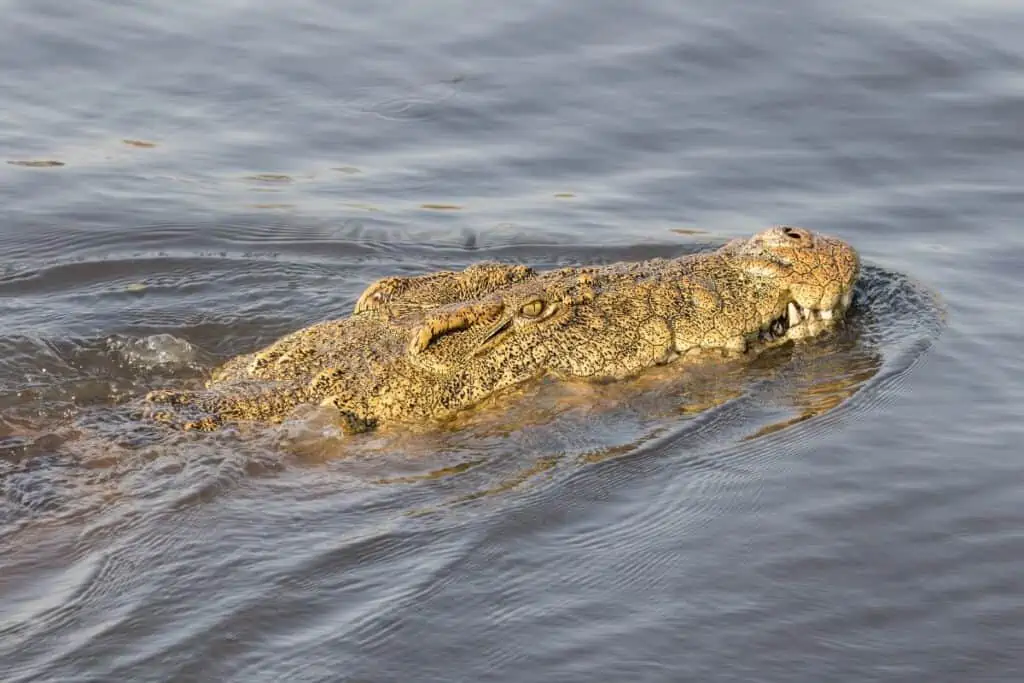
But how can a hippo compete when crocodiles are known to have the world’s strongest bites? First, let’s look at the following eight facts about crocodiles.
- The Nile crocodiles can bite with forces that average around 3,700 psi, which is greater than the hippopotamus’ maximum bite force.
- Although Nile crocodiles and hippos rarely come into contact, crocs have been known to prey on young hippos that venture too far from the protection of their bloat (bloat is the term used for a herd of hippos).
- Crocodiles can move at speeds up to 14 mph on land and 20 mph in the water; however, they cannot sustain this speed for very long.
- Crocodiles are enormous reptiles that can grow to 20 feet long and weigh up to 2,000 pounds. However, they are smaller than hippos overall, despite being longer.
- Because they can see very well underwater, crocodiles can hunt in muddy lakes and rivers.
- The scales or scutes on crocodiles make their hide the toughest in the animal kingdom, with a thick hide that protects them even from most bullet types.
- Crocodiles kill their prey by biting and clamping down on them, spinning and snapping their necks to rip off pieces of meat, or holding them underwater to drown them. This maneuver is known as a death roll.
The fact that crocodiles are patient predators is one of the reasons they are so dangerous. While waiting for prey to approach, they can stay underwater for up to an hour without coming up for air.
Most species are more adaptable than others regarding territorial behavior, except the saltwater crocodile, a highly aggressive and territorial species.
Even though mature male saltwater crocodiles will not tolerate any other males at any time of the year, they will not risk attacking an adult hippo if they ever were to encounter one.
Hippos vs Crocodiles: Comparison Table
Rounding up the above information and a few more essential factors such as senses, defense, and offense, we can determine which of these two animals has the advantage in the animal kingdom.
| Crocodile | Hippo | |
|---|---|---|
| Weight | The average crocodile weighs between 400 to 2,200 pounds | The average adult male hippo weighs between 3,500 to 9,500 pounds |
| Length | Male crocodiles can grow up to 20 feet in length | Hippos can reach lengths of 10 to 16.5 feet |
| Height | Crocodiles can only grow up to heights of around 30 inches. | Hippos can grow to be up to 5.2 feet tall. |
| Offensive Features | Crocodiles have a bite force of up to 3,700 psi. They have 4-inch long teeth. Attack prey with a death roll to remove chunks of flesh. | Adult hippos have a bite force of up to 1,800 PSI. Canines are up to 1.5 feet long, and incisors are up to 1.2 feet long. It uses its weight to crush threats when charging. Hippos can open their mouths as wide as 150 degrees and extend up to four feet. |
| Defensive Features | Crocodiles have tough hides and scales/scutes for protection. Can travel at fast speeds in water and on land | Has 2-inch thick skin. Its size and weight act as a defense against most threats. Can move fast on land. Aggressive behavior. |
| Senses | Excellent vision underwater along with nocturnal vision. Has sensitive sections of skin known as pressure receptors that allow crocs to sense movement around them. | Excellent sense of smell and audible range on land and in water. Has exceptional eyesight underwater. |
| Speed | Can reach short burst speeds of up to 14 mph on land. It can reach up to 20 mph speeds in the water using its tail. | It can reach up to 19 mph on land. It can move at up to 5mph in the water. |
| Predatory Conduct | A patient hunter that ambushes its prey. Only saltwater crocs are territorial. Observed to often coexist with hippos. | Aggressive, protective, and territorial. Observed to often coexist with crocodiles. |
Hippo vs Crocodile: Slaughter In The Water
The effectiveness of an animal as a fighter is greatly influenced by its physical characteristics.
So, based on the information we’ve already discussed, let’s find out who would be higher in the food chain if these two animals were to have a conflict.
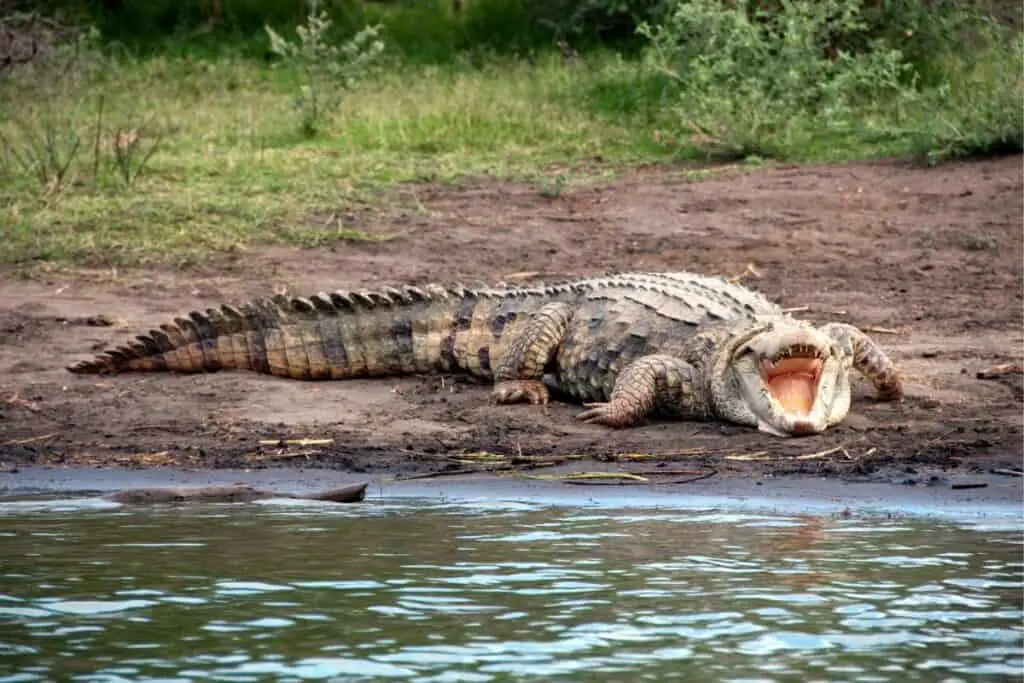
Hippos Have The Size Advantage
Crocodiles are enormous reptiles that can grow to 20 feet in length and weigh up to 2,000 pounds. But they are smaller than hippos overall, despite being longer.
Adult male hippos can weigh up to 9,500 pounds, reach a length of 16 feet, and stand 5 feet tall. So, compared to crocodiles, hippos are massive.
Crocs Are Faster In The Water, Hippos Are Faster On Land
When necessary, some crocodile species can move at speeds of up to 14 mph on land and 20 mph in the water; however, they cannot sustain this speed for very long.
Hippos can move at up to 19 mph for brief periods, but they can only move at five mph when submerged underwater.
As a result, hippos come out on top on land, while crocodiles are the faster animal when it gets wet.
Hippos Have The Intellectual Advantage
A crocodile’s eyes are covered underwater by a transparent eyelid. As a result, they can see very well underwater and hunt in mud-filled lakes and rivers.
They are acutely aware of movement around them because they can sense pressure changes very well. When animals enter their territory, they can react swiftly and violently.
On the other hand, hippos can hear on land and in the water exceptionally well and have excellent senses of smell and vision.
Overall, hippos have better senses and the mental capacity to process those senses. In this regard, hippos are in a better position.
With Better Offense And Defense, Adult Hippos Reign Supreme
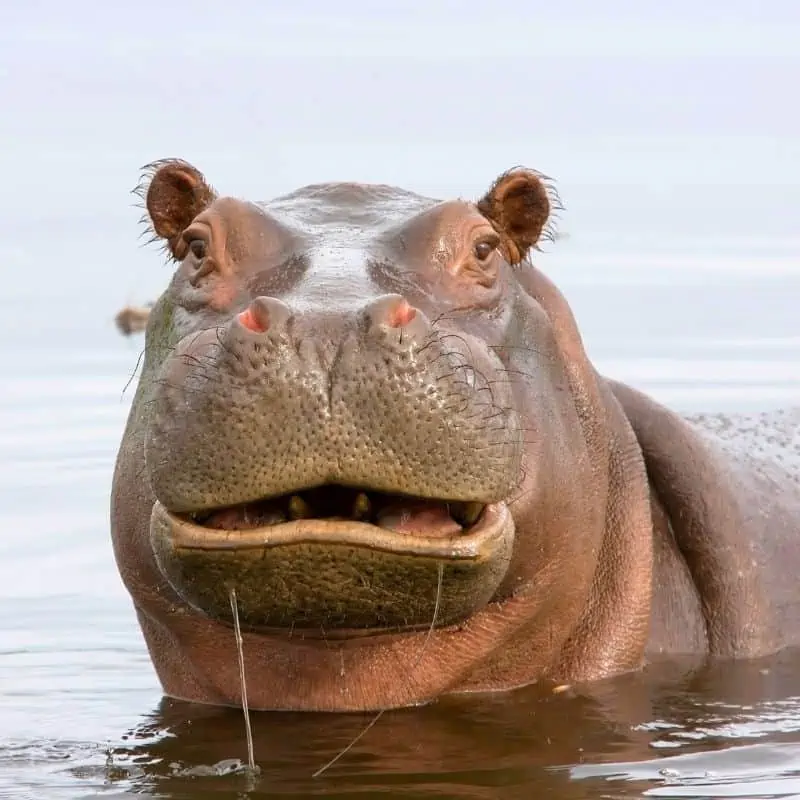
Both crocodiles and hippos use their bites to attack and kill their prey or threats.
Hippos can bite with 1,800 psi of force, and their 20-inch-long, razor-sharp teeth are long, pointed, and deadly.
Crocodiles can slam down on prey with 4-inch teeth and a bite force of 3,700 psi, the strongest of all land animals.
A hippo, however, can easily fit a substantial part of the crocodile in its mouth, given that it has a mouth that can open up to 150 degrees and measures about 4 feet in length.
Moreover, despite having scales that are thick enough even to stop most bullets, crocodiles can still be easily crushed and thrown around due to the 1,800 psi bite pressure and sharp, long tusks that serve as incisors and canines.
Considering the mouth and teeth size of the crocodiles, not only would the crocodile not do enough damage to the 2-inch thick skin of the hippos, but the only part a crocodile can latch onto to perform a death roll is one of the hippos’ legs.
However, considering an adult hippo’s weight, getting to the hippo’s legs and getting stepped on would quickly end this encounter.
Nevertheless, whether or not a crocodile has the opportunity to attack an adult hippo’s legs boils down to how the patient ambusher chooses to strike.
Still, ambushing requires excellent sense, and since hippos are superior in both senses, crocodiles often wouldn’t get the chance to attack an adult hippo.
So it’s safe to say hippos are the rulers in most African waters.
How Do Hippos And Crocodiles Coexist?
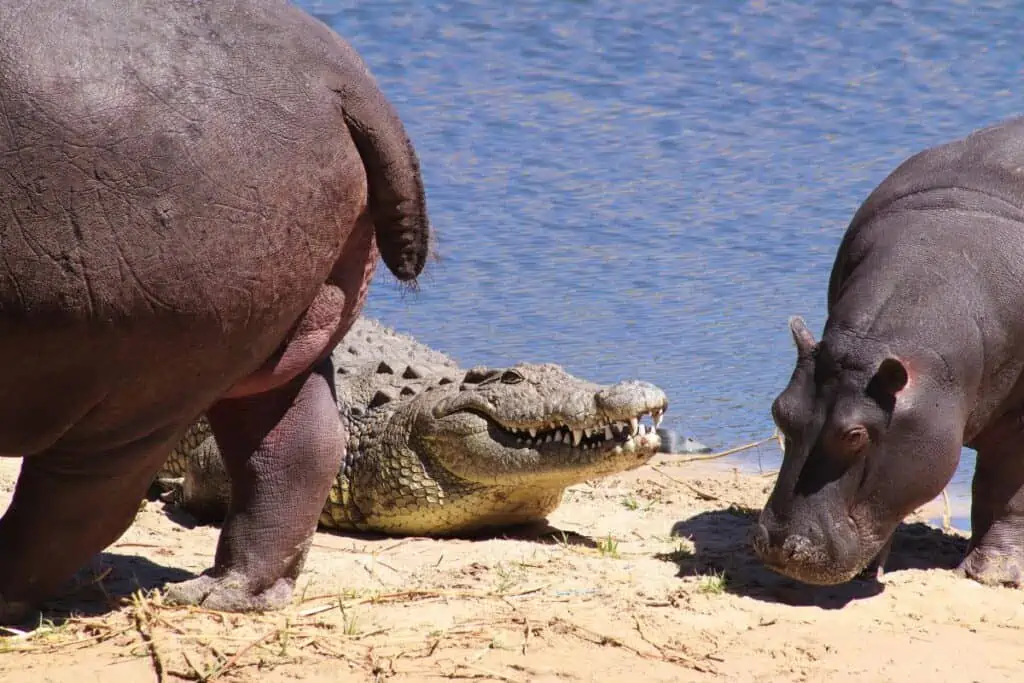
Hippos are herbivores and require a lot of grass to graze on to survive, whereas crocodiles are carnivores and will consume fish and any unwary herbivores that approach the water to drink.
So, since hippos are effectively prey and crocodiles are predators, how can they coexist peacefully next to one another in some of Africa’s larger waterholes?
The truth is that crocodiles would attack and eat a hippo if they had the slightest opportunity, but they don’t because of how dangerous hippos are.
- An adult hippo only needs to open its mouth wide and show off its intimidating sharpened incisors or tusks, combined with its size and thick skin, to ward off a hungry croc.
- As you know, the average-sized adult crocodile does not match the average-sized adult hippo. So given that hippos are frequently found in bloats with many other adults, it would be pointless for a crocodile even to attempt to pursue a young hippo due to the potential harm the other, more seasoned adults could cause.
- Since the hippos are mainly vegetarian, they pose no threat by competing for the same food source as crocodiles. Additionally, crocodiles take a long time to metabolize their food, so they do not need to hunt frequently. Crocodiles only need around 50 meals a year.
Beyond this, hippos and crocodiles have a peculiar and erratic relationship. For example, hippos frequently lick or chew on crocodiles while they feed or sun themselves. Why they do this is still a mystery.
Despite sharing an environment, they tend to avoid each other’s company because they are both aware of what the other is capable of.
You may have come across many documented instances of them attacking one another, but given that they share most of their time in the same space, some conflict is bound to happen occasionally.
However, due to their ingrained survival instincts, their relationship is one of coexistence with little interaction.
Instances Where Hippos Were Intimidated By A Crocodile
There have only been a handful of crocodiles large enough to intimidate hippopotamuses, including “Gustave,” an enormous 18-foot-long beast.
Gustave had a reputation for taking down big game, including water buffalo, hippos, and other crocodiles.
One of the smallest African nations, Burundi, is sandwiched between Tanzania and the Democratic Republic of the Congo. Less than 10 miles separate the bustling capital from the lush, green plains of Rusizi National Park.
Yet, under the water, Gustave the killer croc had powerful jaws and scarred leathery skin and had lurked among the untamed landscape and preyed upon abundant wildlife.
Sadly, the writer of Travel Africa Magazine reported Gustave’s death in a 2019 article about traveling in Burundi.
Nobody has ever come forward with photographic proof, and details of Gustave’s death have not been confirmed, so he may still lurk in the depths.
Final Thoughts On Crocodile vs Hippo Differences
Knowing the amphibious wildlife of Africa can be incredibly fascinating, especially comparing the strengths of a hippo and a crocodile, two waterhole conquerors in Africa.
Hippos and crocodiles can live together in the same habitat, but in a challenge, hippos are strong enough to lift crocodiles from the ground with their giant mouths.
As a result, a hippo would reign supreme in most clashes with a crocodile if they were to occur.
